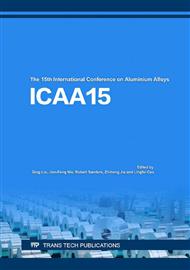p.56
p.62
p.67
p.73
p.78
p.84
p.90
p.97
p.104
Evaluation on the Accuracies of Sump Depth Measurements during DC Casting Process of 7050 Alloy
Abstract:
Present work was carried out to investigate the measurement accuracy of the sump depth for 7050 billet in direct chill (DC) casting process. Three measuring methods were applied: (i) Al-30wt.% Cu melt was poured into the mold at the steady state of the casting attempting to record the profile of billet sump; (ii) two steel rods were vertically dipped into the centreline and the edge of the billet attempting to measure the distances between the solidus and the free liquid surface in the hot-top; (iii) several ordered thermocouples were pre-arranged onto the starting block and they were solidified into the billet as it was cast, and a series of temperature-time curves was recorded after casting. For the purposes of comparison and evaluation, a numerical model based on the same experiment parameters was also built and the simulation results were compared with measured results by above methods. It indicates that the sump depth measured by thermocouples has the best consistency with numerical results. The most accurate method is temperature recoding by thermocouples. The Al-Cu melt pouring method is more accurate than the rods dipping method, and the sump depths measured by later two methods were the positions about the solid fraction (fs) depths of 0.8 to 0.9.
Info:
Periodical:
Pages:
78-83
Citation:
Online since:
November 2016
Authors:
Keywords:
Price:
Сopyright:
© 2017 Trans Tech Publications Ltd. All Rights Reserved
Share:
Citation:


